Porcelain Insulator News
by Elton Gish
Reprinted from "Crown Jewels of the Wire", February 2001, page 15
This month I am finally reporting on two similar and equally rare insulators.
Both are two-part insulators but not transpositions. They were designed to
eliminate the tie-wire by clamping the conductor between the two halves in a
serrated groove formed in the face of the bottom half. In fact, both
insulators were made based on the same patent and both insulators were more than
likely made by the same company. Chances are you still do not know what two
unipart porcelain insulator styles I am describing. The first insulator is a
more recent discovery. The second insulator will be saved for last because there
is a special tragic story associated with it. And a part of insulator history
will be rewritten, too!
The first insulator is U-124 with the embossed marking,
MACY INSULATOR MACY IND. The embossed marking is in a circle around the top.
Several of these have been reported over the years. All have a dark chocolate
brown glaze over dry process porcelain. We are fairly certain they were made by
the Square-D Co. in Peru, IN. Several were reportedly found in Macy, IN.
Evidently they were specially made for telephone service in that town.
The
Square-D Co. is an old company that manufactures and sells all types of
electrical equipment. From 1925 to 1951, the company operated a dry process
porcelain plant at Peru, IN that included the manufacture of pin-type porcelain
insulators. All of the insulators bear markings incorporating either the company
name or their Square-D trademark that was registered in 1922 (used since 1914).
Two of the embossed Square-D markings are in a circle around the top of U-317.
The recess-embossed marking "D" inside a square was used on U-13, U-32,
U-42. Square-D also made the dry-spot U-188 for American Electric Co. and later
Automatic Electric Co. and these have a Square-D identifier marking on the crown
ridge of the insulator's base part.
U-124 was an unusual but rather ho-hum insulator with the unattractive
chocolate brown glaze. It is a hard insulator to find but many people probably
would not find it interesting and desirable enough to add to their collection
because of the chocolate brown glaze. In 1997, Dan Herron found a U-124 with a
matching bottom half in an antique store in Peru, IN. The dealer got it from an
estate sale in Macy, IN. The wire grooves in the bottom part are marked 12 and
14 which indicate the wire gauge (size). Evidently the bottom half does not
survive (more on that in discussion of the next insulator) as this is the only
bottom half known. The Macy insulator should fit in the U-Chart with the other
no-tie insulator styles (U-181 to U-187). Since it has already been assigned
U-124, the complete insulator will be referred to as U-124A/B with U-124A being
the top half. The following photographs of U-124A/B were taken by John and Carol
McDougald and the insulator is now in the collection of Rick Soller.
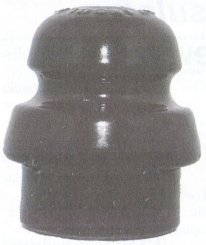
U-124A/B Macy insulator.
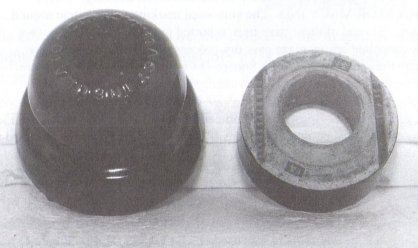
U-124A/B showing embossed marking on the top half
and two sizes of wire
grooves in the bottom half.
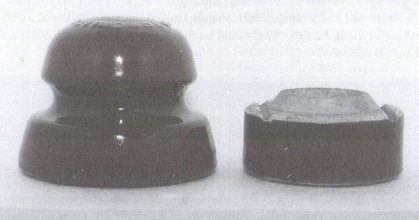
Profile of each half of U-124A/B.
The second insulator is actually the first of the two styles discovered. I
obtained the insulator from the original owner, Gerald Osler. It took some
research to track him down since he moved to another part of the country after
his retirement. Then, it was many months more before he agreed to part with the
insulator with the understanding that I tell the whole story. I encouraged him
for a few years to write down the story but, unfortunately, it was too painful
for him. Now I've lost contact with Gerald. So, I will tell the story as I know
it.
Gerald Osler and his son Jeff (South Bend, IN) were very close and enjoyed
insulator collecting. In early 1972, they reported finding a pretty little
two-part porcelain insulator. Jeff wrote to Jack Tod for his help in identifying
the pretty little insulator, and he put it in Porcelain Insulator News on page
21 of the April 1972 issue of Crown Jewels of the Wire. Jack did not recognize
the insulator, but he knew it was a special style to eliminate the need for a
tie wire. Jeff and his father purchased the insulator for $4 at an antique shop
in northern Indiana. Gerald told me it was in a drawer of an antique wooden
dresser still mounted on the unused wooden side pin. The pin was varnished and
had never been exposed to the weather. In fact, the cute little insulator looked
unused, too. This only known specimen of U-182A/B with varnished pin could have
been a salesman's display sample.
The insulator was made of dry process
porcelain and the glaze is a very unusual speckled tan. The bottom half is
similar to U-124B except it does not have a raised inner ring that extends up
inside the top half, and the numbers "12" and "14" which
indicate the wire size, are located next to the serrated wire grooves.
Unfortunately, the bottom half of the insulator split into three pieces. Apparently it was pushed down snug on the
wooden pin and a temperature change caused the wooden pin to swell resulting in
the breakage. This could be the reason that only one bottom to U-124A/B has
survived.
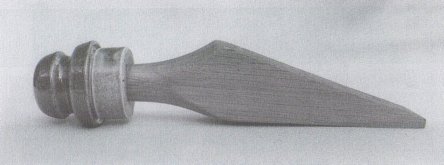
U-182A/B "Prenzel patent insulator.
In the June 1972 issue of Crown Jewels of the Wire, Jack Tod announced that
he determined U-182A/B was made based on the Prenzel patent. The patent is No.
315,660 granted on April 14, 1885. It showed both halves being threaded and
formed with a projection like a square nut so a wrench could be used to tighten
the top halve down on the bottom half thus clamping the conductor wire in
between the two halves. Grooves were formed in the bottom half. The mating
surfaces of the two halves could be formed with concave and convex surfaces to
aid in the secure grip of the conductor wire. The only feature of U-182A/B
matching the Prenzel patent were the grooves formed in the bottom half. You may
begin to wonder why the Prenzel patent is so much different. More importantly,
the patent was granted in 1885 and would have expired in 17 years in 1902. This
is much too early for this insulator to have been made based on the Prenzel
patent.
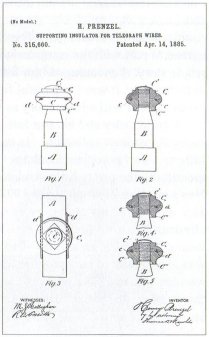
The Sproat and Tarr patent, No. 544,778 granted on August 20,1895, is
very similar to the Prenzel patent and to U-182A/B. The system was the same - two halves screwed together to clamp the conductor between them - and
it also had wire grooves formed in the lower half. There were four grooves, one
on each side of the disk, and parallel to the groove on the opposite side. The
top half had concentric rings formed underneath to help grip the conductor and
hold it in the grooves in the bottom half. This still didn't seem to match U-182A/B. Yes, many insulators made based on a specific patent seldom look similar
enough to the insulator shown in the patent drawing. The patent life of 1895 to
1912 is still somewhat early for U-182A/B.


U-182A/B showing detail of each half.
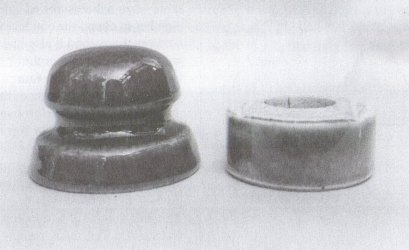
Profile of each half of U-182A/B.
So was U-182A/B really made based on the Prenzel patent as we have always
referred to it? No it was not! Both U-124A/B and U-182A/ B were made based on
the Roberts patent. Patent No. 1,305,168 was granted to Omer L. Roberts on May
27, 1919. The patent drawing does not look much like either insulator but the
claims cover all the bases. Note the tapered side pin in the patent drawing. It
is identical to the one found with U-182A/B! The bottom half of the insulator
does not have a threaded pinhole and the patent claims a groove formed in the
bottom half for the wire. The life of the patent (1919-1936) fits, too, with the
age of U-182A/B. If you still have doubts that the Roberts patent was used for
these two insulators, then you will find it interesting that Omer Roberts lived
in Macy, IN!! Yes, the "Prenzel patent" insulator is actually the
Roberts patent insulator!
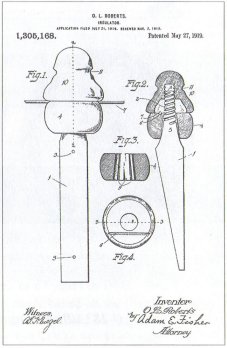
Jack Tod was mislead by the tan glaze color thinking it looked more like the vintage of Fred Locke, so the early date of
the Prenzel patent seemed to fit. However, Fred Locke never used dry process
porcelain.
Now back to the story of the only known specimen of U-182A/B. In 1973
at the Hutchinson, KS 3rd annual National show (where the NIA was born), Gerald
Brown (author of many early books on porcelain insulators) traded for the
U-182A/B (see CJ 9-73-24). He gave Jeff and Gerald Osler several rare glass insulators including a Boston screw-top. Gerald Brown was thrilled to add a
rare porcelain insulator to his collection and ran a photo of the insulator in
the January 1976 issue of Crown Jewels of the Wire. About 3-4 years after Gerald
Brown acquired the insulator, Jeff Osler was tragically killed in a car wreck.
His father was very distraught over the loss of his son whom he had spent many
wonderful years in a close relationship and sharing an exciting hobby. In one of
Gerald Brown's books, Collectible Porcelain Insulators, he added this footnote:
"The OsIers, father and son, were close and dedicated collectors. The son
was killed in an auto accident and the father was devastated. I decided that he
should have the insulator and so sent it to him." I wish that Gerald Osler
could have added more to this story, but I hope it will at least show readers
how our hobby can bring families closer together as well as the quality of
friendships made over the years. It was very gracious for Gerald Brown to return
the insulator. We should all remember that insulators are just objects to enjoy,
and that family and friends are so much more important.
| 